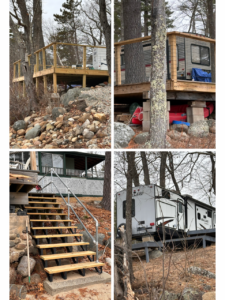Freedom—January 1, 2025—Questions about the need for a professional stormwater management plan for Wabanaki Campground are back in the discussion after an abutting family and Freedom’s Conservation Commission submitted separate letters on the subject last week.
In a related development, the Zoning Officer’s mandate that the business address zoning violations in the shorefront buffer could trigger a provision of the ordinance that would make a whole-property runoff plan mandatory.
Wabanaki owner/manager Mark Salvati wants to convert his 11-acre Ossipee Lake business to a 77-unit shareholder-owned cooperative campground.
He has a site plan application currently before the Planning Board seeking approval to expand and improve a number of rustic “hutnick” structures so they can be added to the inventory of units.
In a letter last week, abutting property owners Maureen and Anthony Raynes, asked the Planning Board not to rule on the site plan application until there is a stormwater management plan for the entire property.
The campground’s long-time neighbors said they support the Conservation Commission’s call for such a plan, saying it was a “coherent, actionable approach” to the site’s environmental issues.
To date, campground owner Salvati has only been required to produce a stormwater management plan for the “hutnicks,” despite reports by Planning Board members after an April site visit that the shoreline is eroded and runoff is funneling debris into the lake.
A board discussion about requiring a comprehensive stormwater plan, including assessing the decades-old drainage system, fizzled after it was found that Freedom’s Site Plan Review Regulations prevent straying from the site plan application as submitted, which pertains solely to the “hutnicks.”

Runoff from the campground is eroding the Ossipee Lake shoreline and pushing debris into the lake. Planning Board members reported the erosion and runoff issue in April. Photo: December 2024.
A subdivision application for the campground conversion was promised at two Planning Board meetings in 2023 but never materialized. The board has not said whether Town Counsel was consulted about the need for a subdivision plan, and the Select Board has declined to comment.
That has left the larger stormwater issue off the Planning Board’s table despite documentation including this video shot in December.
The Conservation Commission’s approach to the runoff issue favored by the Raynes family was detailed in a letter that Commission Chair Jeff Nicoll hand-delivered to the planners at their December 19 meeting.
The letter said the Commission calculated the percentage of impervious surface coverage in the shoreline buffer to be 26%, which exceeds the 25% threshold in the ordinance’s Section 705, beyond which any changes trigger the need for a professional stormwater management plan.
The Commission’s calculation appears to be conservative. DES’s approval of McConkey Construction’s installation of new septic systems on the property in May states the impervious surface coverage to be 29.2%.
After the discussion at the December 19 meeting turned to impervious surfaces, campground owner Salvati said he would remove “Hutnick” #1 from his application. “Hutnick” #1 is inside the 300 ft. buffer.
Commission Chair Nicoll submitted a new letter to the planners the next day, pointing out that while removing “Hutnick” #1 from the site plan application means “no new activity” is being proposed inside the buffer, the campground still exceeds the 25% benchmark.
“Changes [that] represent a departure from grandfathered conditions should “immediately trigger” a stormwater management plan, he wrote.
“Allowing modifications without requiring compliance risks setting a precedent that undermines the intent of Sections 705 and 7.4, both of which prioritize water quality protection and sustainable development.”
In an email to Ossipee Lake Alliance, Salvati said the Conservation Commission’s issues were already raised and considered by the Planning Board at the December meeting.
“We are not proposing substantial work in the 300 foot buffer zone, and we withdrew the only real work we first requested in the setback area,” he said, adding that the Commission is “commenting on a petition [application] that is now nine months old.”
Planning Board Chair Linda Mailhot did not respond to a request to comment on the letters.
23 Zoning Violations
The Conservation Commission Chair was not the only town official at the December 19 meeting. Former Zoning Officer Gary Williams, now a Selectman, was there to inform the planners that he found 23 zoning violations at the campground on a recent site visit.

Decks and other structures in the shoreline buffer said to have been impermissibly constructed this year at Wabanaki Campground. Photos: December 2024.
Williams said the violations included decks and other structures added to trailers, as well as unapproved construction work on the “hutnicks.” He said the remedy for the violations would be to “bring the decks up to the 2021 building code.”
He gave the board a letter sent to Salvati calling the violations “serious” and saying he could be fined as much as $62,975 if he doesn’t address them in “a timely manner.” Salvati posted a comment on Ossipee Lake Alliance’s website saying he will comply and pay fines for any violation he does not dispute.
The town’s letter to Salvati, which is unsigned, does not list the 23 individual violations, does not state where the violations are located on the property, and does not provide a deadline for compliance.
Williams’s verbal description of the violations to the board, however, suggests that many of them are inside the shoreline buffer, which would be consistent with photos that have circulated in recent days.
That has prompted speculation about whether work on the structures identified as being in violation would constitute the kind of change to trigger the stormwater plan requirement in Section 705 of the ordinance.
That’s the view of a retired planner from a neighboring town who is familiar with Freedom’s regulations. The official questioned why Freedom would require the illegal structures to be rebuilt instead of removed, given the high level of impermeable surface coverage.
“Reducing the percentage of impermeable surfaces should be the town’s environmental goal because the property is densely developed and right on the lake,” said the official, who asked not to be identified by name.
“Looking at the pictures, I don’t see how the structures in question are approvable in any way.”
The official also pointed to Section 8 of Freedom’s Site Plan Regulations, which grants the Planning Board authority to require an Environmental Impact Statement.
The official said the Planning Board has a lot of discretion if it wants to use its Section 8 authority, since there isn’t an official definition of an Environmental Impact Statement, and the need for one can be determined by the board on a case by case basis.
“I’m surprised the Planning Board didn’t require one as soon as it found itself dealing with serious environmental questions with one hand tied behind its back.”
